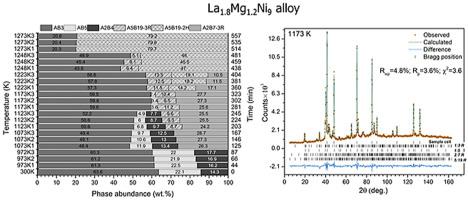Progress in Natural Science: Materials International ( IF 4.7 ) Pub Date : 2021-09-10 , DOI: 10.1016/j.pnsc.2021.06.008 ChuBin Wan 1, 2 , R.V. Denys 1, 3 , V.A. Yartys 1

|
The present work is focused on the studies of the phase-structural transformations in the La3-xMgxNi9 (x = 1.0, 1.1 and 1.2) alloys as active materials of negative electrodes in the Nickel-Metal Hydride (Ni/MH) batteries. The phase equilibria and phase-structural transformations in the alloys were probed by in situ neutron powder diffraction (NPD) at the temperatures ranging from 300 K to 1273 K using the measurements of the equilibrated alloys at 8 setpoint temperatures of 300, 973, 1073, 1123, 1173, 1223, 1248 and 1273 K.
Prepared by induction melting initial alloys were found to be multi-phase structured, containing up to 6 individual intermetallic compounds with different stoichiometric compositions. With the increase of the temperature and holding time, various transformations took place in the studied alloys. These included the formations and transformations of super-stacking intermetallics with variable ratios (La + Mg)/Ni, 1:3, 2:7 and 5:19.
With increasing temperatures, several systematic changes took place. (a) Abundances of (La,Mg)2Ni4 AB2 and (La,Mg)Ni3 AB3 type intermetallics gradually decreased before they melted/decomposed above 1073 K; (b) The (La,Mg)2Ni7 A2B7 type intermetallics began to decrease in abundances above 1123 K; (c) The transformation in the (La,Mg)5Ni19 intermetallics from 3R to 2H proceeded above 1223 K.
The increase of Mg content had no obvious influence on (La,Mg)2Ni4 and (La,Mg)2Ni7 phases, and corresponding reactions R1 and R3 took place at the same temperatures as in the La–Ni system. However, with increasing Mg content the melting point of (La,Mg)5Ni19 phase increased while the melting point of the (La,Mg)Ni3 phase it decreased, leading to the variation of the reaction temperatures of the corresponding processes.
The present study will assist in optimizing phase-structural composition of the alloys in the La–Mg–Ni system which contain Mg-modified layered structures by tailoring the high temperature annealing conditions.
中文翻译:

通过原位中子粉末衍射研究了解 Mg 含量对 La3-xMgxNi9 合金相变的影响
目前的工作集中在相结构转变的研究中的La 3-x Mg的X镍9(X = 1.0,1.1和1.2)的合金作为镍-金属氢化物负电极的活性材料(镍/MH) 电池。合金中的相平衡和相结构转变通过原位中子粉末衍射 (NPD) 在 300 K 至 1273 K 的温度范围内使用平衡合金在 8 个设定点温度 300、973、 1073、1123、1173、1223、1248 和 1273 K。
发现通过感应熔化制备的初始合金是多相结构的,包含多达 6 种具有不同化学计量组成的独立金属间化合物。随着温度和保温时间的增加,所研究的合金发生了各种转变。其中包括具有可变比率 (La + Mg)/Ni、1:3、2:7 和 5:19 的超级堆叠金属间化合物的形成和转变。
随着温度的升高,发生了一些系统性变化。(a) (La,Mg) 2 Ni 4 AB 2和(La,Mg)Ni 3 AB 3型金属间化合物的丰度在1073 K以上熔化/分解之前逐渐减少;(b) (La,Mg) 2 Ni 7 A 2 B 7型金属间化合物的丰度在 1123 K 以上开始减少;(c) (La,Mg) 5 Ni 19金属间化合物从 3R 到 2H的转变在1223 K 以上进行。
Mg含量的增加对(La,Mg) 2 Ni 4和(La,Mg) 2 Ni 7相没有明显影响,相应的反应R1和R3发生在与La-Ni体系相同的温度下。然而,随着Mg含量的增加,(La,Mg) 5 Ni 19相的熔点升高,而(La,Mg)Ni 3相的熔点降低,导致相应过程的反应温度发生变化。
本研究将有助于通过调整高温退火条件来优化含有 Mg 改性层状结构的 La-Mg-Ni 系统中合金的相结构组成。


























 京公网安备 11010802027423号
京公网安备 11010802027423号